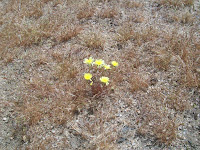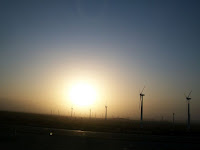To See a Heaven in a Wild Flower
That is, if you're paying attention.
For some, like the desert marigold, life is a brief event, a brave foray into an inhospitable world. According to my reference it "thrives in dry, poor soils, in "extreme heat". The volunteer rye grass that sprouted up after the early rains has withered and died all around it, but the marigold soldiers on. Here on the sun-baked strip of bare dirt next to the street, it puts up a handful of small flowers to attract a pollinator, so that it can go to seed and spawn a generation of children it will not live to see. In more favorable areas, there are armies of marigolds crowded along the street, bright yellow advertisements for spring. But here there are only a few, like pioneers trying to stake a claim in a new land.
It is not simply a matter of enduring the heat and lack of water and nutrients that the marigold is facing. Jostling for resources alongside are other plants, doing their best to co-opt what little there is. These are the "nasties" - cheat grass and goat's-head and Russian thistle (tumbleweeds), armed with stickers and spines and thorns. The rye grass generally crowds them out, except along this dry strip of bare soil where the rye is sparse. Plants here can be as dangerous as the animals, armed and armored and poisonous. All of this protection is not just directed at possible animal predators; several desert plants produce chemicals against other plants.
Despite all of this, there is an order to be seen here. The relationships between the different plants extend to the different animals that feed on them, or make homes among them. Small birds perch easily on the dagger-like leaves of the Joshua Tree, whose points will easily penetrate leather gloves, diving into cover among them when a hawk circles overhead. Chipmunks fearlessly feed among the cholla cactus, known for its "jumping" balls of hooked spines, the bane of men and dogs.
It's small wonder that the desert makes many people uncomfortable. You can see it in their actions - the desperate way that they try to establish their presence in a land that does not acknowledge them. They talk louder against the background of silence, they pile up rocks to disrupt the emptiness, they mark the landscape with graffiti to show their passage. The desert reminds them that they are just passengers here, and it regularly consumes the heedless and the careless. Life in the desert is a careful, delicate dance with death, even as hope quietly blooms.



Comments
Post a Comment
The topic is the bolded sentence at the beginning of each post. Comments should pertain to that subject. Something more than "Like" or "You're wrong" is requested.